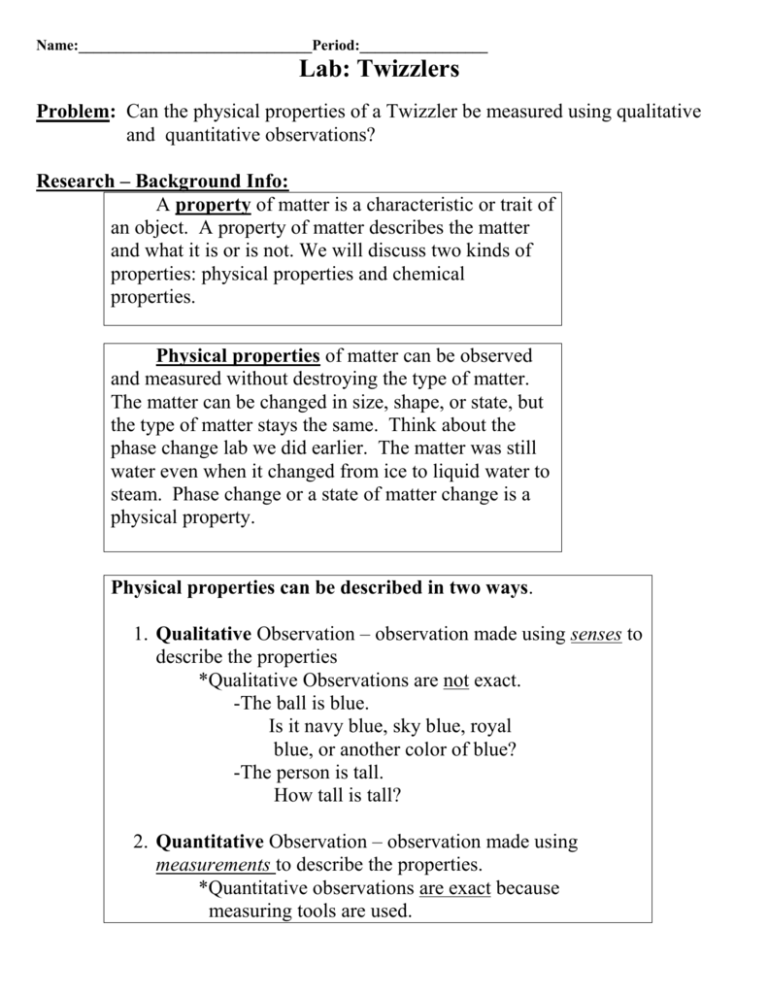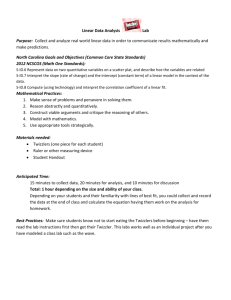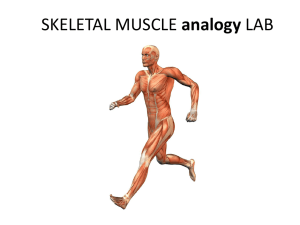Name:
advertisement

Name:_______________________________Period:_________________ Lab: Twizzlers Problem: Can the physical properties of a Twizzler be measured using qualitative and quantitative observations? Research – Background Info: A property of matter is a characteristic or trait of an object. A property of matter describes the matter and what it is or is not. We will discuss two kinds of properties: physical properties and chemical properties. Physical properties of matter can be observed and measured without destroying the type of matter. The matter can be changed in size, shape, or state, but the type of matter stays the same. Think about the phase change lab we did earlier. The matter was still water even when it changed from ice to liquid water to steam. Phase change or a state of matter change is a physical property. Physical properties can be described in two ways. 1. Qualitative Observation – observation made using senses to describe the properties *Qualitative Observations are not exact. -The ball is blue. Is it navy blue, sky blue, royal blue, or another color of blue? -The person is tall. How tall is tall? 2. Quantitative Observation – observation made using measurements to describe the properties. *Quantitative observations are exact because measuring tools are used. Chemical Properties of matter can only be observed by having the matter undergo a chemical change. To see if vinegar and baking soda will react, you have to put the vinegar and baking soda together. When the vinegar and baking soda react, they change into new substances, and the vinegar and baking soda do not exist any longer. Instead, sodium acetate, water, and carbon dioxide gas are made from the rearrangement of the atoms in the vinegar and baking soda. Whenever the new substances are formed, the mass of matter stays the same because matter can not be created or destroyed. Only the atoms and molecules are rearranged to make another type of matter. Experiment: Materials: One Twizzler Ruler Balance Clean tissues Procedure: 1. Wash and dry your hands. 2. If you are sick, please do not touch the Twizzler. 3. Put a clean tissue on the table. Your Twizzler will go on the tissue. We are trying to keep it germ free so that you can eat it when we are done. 4. Identify the color of the Twizzler. Record the information on the data table . 5. What shape is the Twizzler? Record the information on the data table. 6. What does the Twizzler smell like? Record the information on the data table. 7. Texture is how something feels. What is the texture of the Twizzler? Record the information on the data table. 8. Use the ruler and measure the length of the Twizzler. Record the information on the data table. 9. Diameter is the distance from one side to another across the middle. Use the ruler and measure the diameter of the Twizzler. Record the information on the data table. 10. Use the balance and measure the mass of the Twizzler. Record the information on the data table. 11. Ductibility is the ability of an object to stretch without breaking. How ductile is the Twizzler? 12. Calibrate the balance. 13. Put a tissue on the balance. 14. Put the Twizzler on the balance on top of the tissue. 15. Find the mass of the Twizzler. (We are going to ignore the mass of the tissue.) Record the information on the data table. 16. DO NOT TOUCH the riders on the balance. Leave them where they are. Record the information on the data table. 17. Break the Twizzler into an even number of pieces and put the pieces back on the balance. Record the information on the data table. 18. You may eat the Twizzler as you finish answering the questions. 19. . Property Observation color shape smell texture Length diameter Ductibility Mass Mass after breaking into pieces Analyze Data: color, shape, smell, texture, 1. Identify all qualitative properties from the data table.__ ductibility _ 2. Identify all quantitative properties from the data table.__ length, diameter, mass, mass after breaking into pieces 3. Are the properties you just observed about the Twizzler physical or chemical properties?_ physical__ The kind of matter making up Twizzler was not changed. Physical properties are observed by not changing the matter into another type of matter. _____________ Explain.___ 4. Why did the mass of the Twizzler stay the same?________________________________________________ Law of Conservation of Matter – matter was not added or taken away from the twizzler – the twizzler was just broken into pieces 5. Would qualitative or quantitative properties be more useful to scientists?__ quantative __ Anyone should be able to measure the properties and have the same answer. The qualitative properties might not be the same for all observers; people might not see the same color. _________ Explain._ Conclusion: Write a one paragraph summary of this lab. Do NOT use the conclusion template usually used. We measured the __________________ properties of a Twizzler using qualitative and quantitative observations. ___________________ properties were measured because the kind of matter in the Twizzler _________________________________ ______________________________________________________. Qualitative observations were (use data)______________________ ______________________________________________________ ______________________________________________________ ______________________________________________________ because_______________________________________________ ______________________________________________________. Quantitative observations were (use data)____________________ _____________________________________________________ ______________________________________________________ because ______________________________________________ ______________________________________________________. The mass of the Twizzler before breaking into pieces and after breaking into pieces was _______________________________ because _____________________________________________ ____________________________________________________ _____________________________________________________. This lab showed ________________________________________ ______________________________________________________ ______________________________________________________ because _______________________________________________ ______________________________________________________ ______________________________________________________ ______________________________________________________. Must include: -Thesis (based on problem) -physical properties, not chemical were observed (matter was not changed to make observations) -specific qualitative properties observed and why (color, shape, smell, texture, ductibility – not everyone will agree about these observations – used senses) -specific quantitative properties observed and why (length, diameter, mass, mass after breaking into pieces – everyone should be able to make the measurements that are the same within a small range – used measurement tools) -Law of Conservation of Matter (mass before and after breaking was the same because matter was not added or taken away) -concluding sentence (This experiment showed…)







